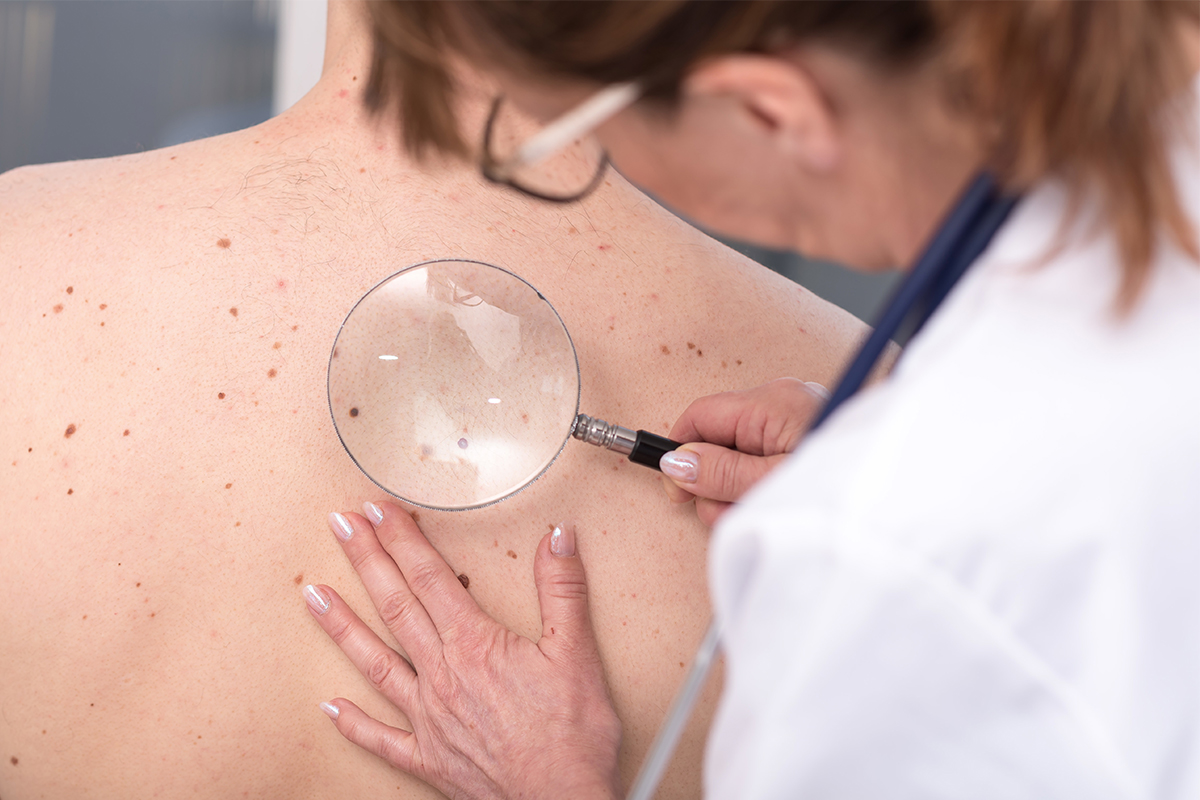Project Description
MOLES
Learn about moles and how Knoxville Institute of Dermatology can help you.
Very few moles actually require medical treatment, but a mole that is evolving in shape, size, texture or color could be indicative of a cancerous growth. The providers at Knoxville Institute of Dermatology are experts in assessing all types of moles. If you have a mole that displays any of these type of changes contact our office today for an evaluation.
What is a mole?
A mole is a common benign skin lesion due to a local proliferation of pigment cells (melanocytes). It is more correctly called a melanocytic nevus, and is sometimes also called a naevocytic nevus. A brown or black mole contains the pigment melanin, so may also be called a pigmented nevus. A mole can be present at birth (congenital nevus) or appear later (acquired nevus). There are various kinds of congenital and acquired nevi.
Who gets moles?
Almost everyone has at least one mole.
- About 1% of individuals are born with one or more congenital melanocytic nevi. This is usually sporadic, with rare instances of familial congenital nevi.
- Fair-skinned people tend to have more moles than darker skinned people.
- Moles that appear during childhood (aged 2 to 10 years) tend to be the most prominent and persistent moles throughout life.
What causes moles?
Although the exact reason for local proliferation of nevus cells is unknown, it is clear that the number of moles a person has depends on genetic factors, on sun exposure, and on immune status.
- People with many moles tend to have family members that also have many moles, and their moles may have a similar appearance.
- New melanocytic nevi may erupt following the use of BRAF inhibitor drugs (vemurafenib, dabrafenib).
- Immunosuppressive treatment leads to an increase in numbers of nevi.
What are the clinical features of moles?
Moles vary widely in clinical, dermatoscopic and histological appearance.
- They may arise on any part of the body.
- Moles differ in appearance depending on the body site of origin.
- They may be flat or protruding.
- They vary in color from pink or flesh tones to dark brown, steel blue, or black.
- Light skinned individuals tend to have light-colored moles and dark skinned individuals tend to have dark brown or black moles.
- Although mostly round or oval in shape, moles are sometimes unusual shapes.
- They range in size from a couple of millimeters to several centimeters in diameter.
What are the complications of moles?
People worry about moles because they have heard about melanoma, a malignant proliferation of melanocytes that is the most common reason for death from skin cancer.
- At first, melanoma may look similar to a harmless mole, but in time it becomes more disordered in structure and tends to enlarge.
- People with a greater number of moles have a higher risk of developing melanoma than those with few moles, especially if they have over 100 of them.
Moles sometimes change for other reasons than melanoma, for example following sun exposure or during pregnancy. They can enlarge, regress or involute (disappear).
- A Meyerson nevus is itchy and dry because it is surrounded by eczema.
- A Sutton or halo nevus is surrounded by a white patch, and fades away over several years
- A recurrent nevus is one that appears in a scar following surgical removal of a mole — this may have an odd shape.
How is a mole diagnosed?
Moles are usually diagnosed clinically by their typical appearance. If there is any doubt about the diagnosis, an expert may be consulted in person or with the help of clinical and dermatoscopic images. This is especially important if:
- A mole changes size, shape, structure or color
- A new mole develops in adult life (> 40 years)
- It appears different from the person’s other moles (a so-called ugly duckling)
- It has ABCD characteristics (Asymmetry, Border irregularity, Color variation, Diameter > 6 mm)
- It is bleeding, crusted or itchy
Most skin lesions with these characteristics are actually harmless when evaluated by an expert using dermatoscopy. Short-term digital dermatoscopic imaging may be used in equivocal flat lesions to check for change over time.
Nevi that remain suspicious for melanoma are excised for histopathology (diagnostic biopsy). Partial biopsy is not recommended, as it may miss an area of cancerous change.
What is the treatment for moles?
Most moles are harmless and can be safely left alone. Moles may be removed in the following circumstances:
- To exclude cancer
- The mole is a nuisance: perhaps irritated by clothing, comb or razor
- Cosmetic reasons: the mole is unsightly
Surgical techniques include:
- Excision biopsy of flat or suspicious mole
- Shave biopsy of protruding mole
WHAT OUR PATIENTS SAY
I have already recommended Dr Raman to a friend. The timeliness getting an appointment, the Covid safe setting, the efficiency of the staff along with the expertise of the doctor are reasons I will return and refer.
I had a recurring dermatological condition for several and a series of dermatologists as a result. And yet until I met Dr. Wright, my condition remained undiagnosed and it turned out to be potentially life-threatening. I am so fortunate to have found him and I would not go to anyone else and recommend him often.
Timely, professional, thorough and took the time to explain the procedure being done and options for upcoming needed procedure. Steps were taken to protect employees and patients against Covid challenges. I had basil cell removed three times and in different states. This office is the best hands down.
This office is very clean, professional and I never have to wait excessive time for my appointment. Dr. Rahman is so thorough and caring and kind. I have had Mohs surgery with Dr. Wright on my face and you cannot even see where the scar is. This is the place to go for your dermatology needs.
I’ll be 77 years old in a month and this was my first real skin check-up. I sort of had one a few years ago at a different place but was turned off by their emphasis on selling cosmetic treatments when I wanted to know about skin disease. Dr. Bakke and his assistant seemed to give me a thorough check, burned off some spots, took.a few biopsies, and I was good to go.
Everyone is so nice and friendly…the office staff is caring, professional and an asset to your institution. Even though I’ve been going to your office for a few years this is the first time I saw Kegan Reilly. He was very professional and very knowledgeable. He explained everything to me in detail and made me very comfortable in an uncomfortable situation. I highly recommend him for anyone who needs to see a dermatologist. He is definitely an exceptional medical provider.
I will be forever grateful to Dr. Anderson for her careful skin exam and detection of the start of a melanoma on my arm. She is pleasant, professional, and kind– everything you would want in a dermatologist.
Dr. Anderson and her staff are excellent. I have been a client for several years. I have received the best care. Dr. Anderson is excellent in discovering and treating. problems. Dr. Anderson listens and is honest.
The whole experience was a positive one… getting an appointment to see someone relatively soon, receiving several reminders, the (covid) health protections at the office, and the very pleasant and knowledgeable care of Lindsey Best FNP, at my appointment.
Sent email & text to inform of arrival procedures, took proper covid-19 protocol to ensure my safety and that of staff and other patients. Doctor and nurse took time to explain what would happen during visit and answered all questions. Explained proper home care of procedure site, made sure I knew how and informed to call office if any problems or questions. Everyone was very helpful, friendly and professional.
Contact Provider via Patient Portal
To access your portal, type kid.ema.md into a Mozilla Firefox browser. Your username will be your personal email address that needs to be provided to the front desk staff. A link will be sent to that [...]
Welcome Nathan Bowers, MD, PhD
Nathan Bowers began his training by earning a PhD in Immunology at the University of Alabama at Birmingham. Driven by a lifelong desire to care for patients in a clinical setting, he then [...]
New Location: Morristown!
Knoxville Institute of Dermatology is excited to announce our newest location in Morristown! We will be located in the Baptist Eye Surgeons building and seeing patients starting in January 2023. Call our office today [...]
Updated COVID-19 Guidelines
Thank you for your continued patience and understanding as we have taken the progressive steps to keeping our practice open for all of your dermatological needs during these unprecedented times. As always, the health [...]
World Psoriasis Day
It's almost October 29th and our physicians and staff are PSO excited to celebrate World Psoriasis Day! World Psoriasis Day is a campaign held annually on October 29th aiming to bring awareness to this [...]
October is Breast Cancer Awareness Month
October is Breast Cancer Awareness month. This annual month-long campaign is designed to bring awareness to one of the most common cancers, aside from skin cancer, in women. Each year in the United States, more [...]









